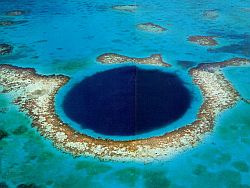Subaquatic Spring
Subaquatic karst spring (underwater spring): spring emerging below the water level. (umbrella term)
Subfluvial karst spring: spring emerging in a watercourse aka river.
Sublacustrine karst spring: spring emerging in a lake.
Submarine karst spring: spring emerging under the sea.


Subaquatic springs refer to those springs that emerge in a body of water below the surface, which is not the body of water that originates in the spring. In other words, the spring lake of a Vaucluse-type spring is not a subaquatic spring, a spring below the sea or a huge lake is. The submarine springs are also scientifically called submarine groundwater discharge (SGD), a term which concentrates on the water and not on the spring. In Australia, submarine karst spring are also called Wonky holes.
A subaquatic spring is usually formed by a karstified layer covered by an impermeable layer that reaches below the water body. Where the cover layer ends, the water emerges, often even under pressure. There are similarities to artesian springs. Subaquatic springs can sometimes be recognised by the welling up of the water or by gas bubbles (carbon dioxide). However, most such springs are very inconspicuous, so they are rarely recognised. Especially with freshwater, such springs can be very difficult to find unless they are very strong or at least sometimes have a sediment load.
A cave system usually forms in the level of the karst water table, and thus follows the gradient of the water table to the source. The only way such a cave system ends up underwater is if the water has risen later. In the case of lakes, this is relatively simple; a landslide causes a blockage and a lake is dammed. Or the river becomes much smaller, instead of digging the valley deeper, debris is deposited and the valley floor rises. This happened especially during the post-glacial rise in sea level with caves that drained towards sea level. The lowest sea level during the last cold period was about 120 m lower than today. Another spectacular event was the Messinian salinity crisis. At that time, the Mediterranean Sea had no connection to the Atlantic Ocean, it dried up and became salty, and the sea level was 250 m lower. Accordingly, an underground drainage formed to this level. After the Strait of Gibraltar was open again, the sea level rose again and the cave systems of the Mediterranean countries drowned.
Often the sources are a shaft of the cave from which the water rises vertically. When these shafts are visible from above, they stand out because of their intense blue colour and are called Blue Hole. The rising water sometimes causes clearly visible surges on the water surface. This effect is quite famous not far from the Beatus Cave in Lake Thun, or off the coast of Slovenia. Moreover, fresh water is lighter than salty seawater, and therefore floats on the sea. So you can sometimes see the submarine springs through freshwater lenses. Such springs were of course also popular with ships, which could fill their water barrels without going ashore.
The use of freshwater springs in the sea is not new, it has been done since the Romans. In Spain, the cave behind such a spring was explored by cave divers, then made accessible through a tunnel, and the water was tapped there. However, this also rendered the dam, which the Romans had built into the sea, non-functional. Alexander von Humboldt reported the collection of sweet water off the coast of Cuba. In the 1950s and 60s, however, this was taken a step further. The springs off the Yugoslavian coast were captured with dams and actually used for water supply. Of course, with the restrictions that apply to all karst springs. There is also such a project in Greece, on the island of Crete, which was carried out only a few years ago.
Literature
- Perrine Fleury, Michel Bakalowicz, Ghislain de Marsily (2007): Submarine springs and coastal karst aquifers: A review, Journal of Hydrology, Volume 339, Issues 1–2, 2007, Pages 79-92, ISSN 0022-1694. sciencedirect DOI pdf
- N. Moosdorf, T. Oehler (2017): Societal use of fresh submarine groundwater discharge: An overlooked water resource, Earth-Science Reviews, Volume 171, 2017, Pages 338-348, ISSN 0012-8252. sciencedirect DOI pdf
- Examples
 Anavalos Spring, Greece
Anavalos Spring, Greece Pupu Springs, New Zealand
Pupu Springs, New Zealand St Paul Subterranean River National Park, The Phillipines
St Paul Subterranean River National Park, The Phillipines
 Search DuckDuckGo for "Subaquatic Spring"
Search DuckDuckGo for "Subaquatic Spring" Submarine groundwater discharge - Wikipedia (visited: 30-OCT-2022)
Submarine groundwater discharge - Wikipedia (visited: 30-OCT-2022) Submarine Spring (visited: 30-OCT-2022)
Submarine Spring (visited: 30-OCT-2022)
 Index
Index Topics
Topics Hierarchical
Hierarchical Countries
Countries Maps
Maps